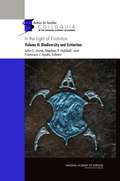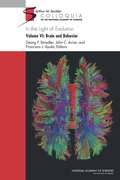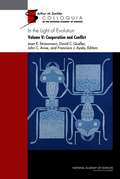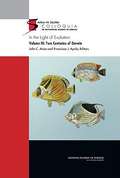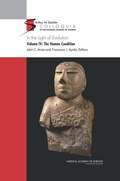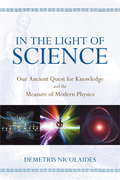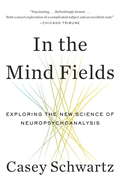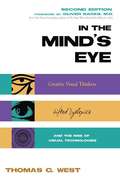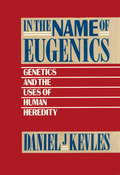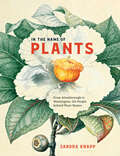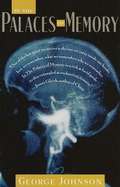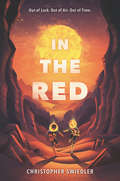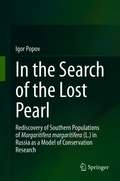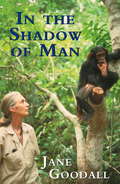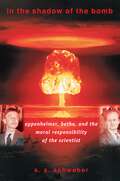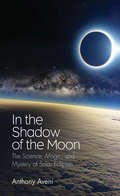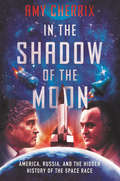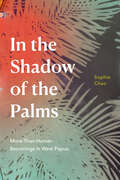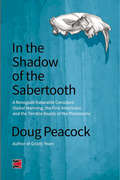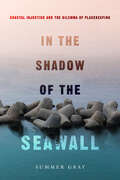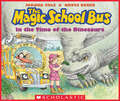- Table View
- List View
In the Light of Evolution: Biodiversity and Extinction
by National Academy of Sciences of the National AcademiesThe current extinction crisis is of human making, and any favorable resolution of that biodiversity crisis--among the most dire in the 4-billion-year history of the Earth--will have to be initiated by mankind. Little time remains for the public, corporations, and governments to awaken to the magnitude of what is at stake. This book aims to assist that critical educational mission, synthesizing recent scientific information and ideas about threats to biodiversity in the past, present, and projected future. This is the second volume from the In the Light of Evolution series, based on a series of Arthur M. Sackler colloquia, and designed to promote the evolutionary sciences. Each installment explores evolutionary perspectives on a particular biological topic that is scientifically intriguing but also has special relevance to contemporary societal issues or challenges. Individually and collectively, the ILE series aims to interpret phenomena in various areas of biology through the lens of evolution, address some of the most intellectually engaging as well as pragmatically important societal issues of our times, and foster a greater appreciation of evolutionary biology as a consolidating foundation for the life sciences.
In the Light of Evolution
by National Academy Of Sciences Georg F. Striedter Francisco J. Ayala John C. AviseThe central goal of the In the Light of Evolution (ILE) series is to promote the evolutionary sciences through state-of-the-art colloquia--in the series of Arthur M. Sackler colloquia sponsored by the National Academy of Sciences--and their published proceedings. Each installment explores evolutionary perspectives on a particular biological topic that is scientifically intriguing but also has special relevance to contemporary societal issues or challenges. This book is the outgrowth of the Arthur M. Sackler Colloquium "Brain and Behavior," which was sponsored by the National Academy of Sciences on January 20-21, 2012, at the Academy's Arnold and Mabel Beckman Center in Irvine, CA. It is the sixth in a series of Colloquia under the general title "In the Light of Evolution." Specifically, In Light of Evolution: Brain and Behavior focuses on the field of evolutionary neuroscience that now includes a vast array of different approaches, data types, and species. This volume is also available for purchase with the In the Light of Evolution six-volume set.
In the Light of Evolution: Cooperation and Conflict
by Joan E. Strassmann David C. Queller John C. Avise Francisco J. AyalaThis book is the outgrowth of the Arthur M. Sackler Colloquium "Cooperation and Conflict," which was sponsored by the National Academy of Sciences on January 7–8, 2011, at the Academy’s Arnold and Mabel Beckman Center in Irvine, California. It is the fifth in a series of colloquia under the general title "In the Light of Evolution." The first four books in this series were titled Adaptation and Complex Design (Avise and Ayala, 2007), Biodiversity and Extinction (Avise et al., 2008), Two Centuries of Darwin (Avise and Ayala, 2009a), and The Human Condition (Avise and Ayala, 2009b). The current volume explores recent developments in the study of cooperation and conflict, ranging from the level of the gene to societies and symbioses. <P> Any student of history knows that we humans can be a vicious lot, but paradoxically we are also among nature’s great cooperators. Which of us, as an individual, can manufacture a cell phone or an airplane? Even our great conflicts—wars—are extremely cooperative endeavors on each side. Some of this cooperation is best understood culturally, but we are also products of evolution, with bodies, brains, and behaviors molded by natural selection. How cooperation evolves has been one of the big questions in evolutionary biology, and how it pays or does not pay is a great intellectual puzzle.
In the Light of Evolution Volume III: Two Centuries of Darwin
by National Academy of Science the National AcademiesTwo Centuries of Darwin is the outgrowth of an Arthur M. Sackler Colloquium, sponsored by the National Academy of Sciences on January 16-17, 2009. In the chapters of this book, leading evolutionary biologists and science historians reflect upon and commemorate the Darwinian Revolution. They canvass modern research approaches and current scientific thought on each of the three main categories of selection (natural, artificial, and sexual) that Darwin addressed during his career. Although Darwin's legacy is associated primarily with the illumination of natural selection in The Origin, he also contemplated and wrote extensively about what we now term artificial selection and sexual selection. In a concluding section of this book, several science historians comment on Darwin's seminal contributions. Two Centuries of Darwin is the third book of the In the Light of Evolution series. Each installment in the series explores evolutionary perspectives on a particular biological topic that is scientifically intriguing but also has special relevance to contemporary societal issues or challenges. The ILE series aims to interpret phenomena in various areas of biology through the lens of evolution and address some of the most intellectually engaging, as well as pragmatically important societal issues of our times.
In the Light of Evolution Volume IV: The Human Condition
by National Academy of Sciences of the National AcademiesThe Human Condition is a collection of papers by leading evolutionary biologists and philosophers of science that reflect upon the Darwinian Revolution as it relates to the human condition at levels ranging from the molecular to the theological. The book focuses on understanding the evolutionary origin of humans and their biological and cultural traits. The Human Condition is organized into three parts: Human Phylogenetic History and the Paleontological Record; Structure and Function of the Human Genome; and Cultural Evolution and the Uniqueness of Being Human. This fourth volume from the In the Light of Evolution (ILE) series, based on a series of Arthur M. Sackler colloquia, was designed to promote the evolutionary sciences. Each volume explores evolutionary perspectives on a particular biological topic that is scientifically intriguing but also has special relevance to contemporary societal issues or challenges. Individually and collectively, the ILE series interprets phenomena in various areas of biology through the lens of evolution, addresses some of the most intellectually engaging as well as pragmatically important societal issues of our times, and fosters a greater appreciation of evolutionary biology as a consolidating foundation for the life sciences.
In the Light of Science
by Demetris NicolaidesThe birth of science in ancient Greece had a historical impact that is still being felt today. Physicist Demetris Nicolaides examines the epochal shift in thinking that led pre-Socratic philosophers of the sixth and fifth centuries BCE to abandon the prevailing mythologies of the age and, for the first time, to analyze the natural world in terms of impersonal, rationally understood principles. He argues not only that their conceptual breakthroughs anticipated much of later science but that scientists of the twenty-first century are still grappling with the fundamental problems raised twenty-five hundred years ago.Looking at the vast sweep of human history, the author delves into the factors that led to the birth of science: urbanization, the role of religion, and in Greece a progressive intellectual curiosity that was unafraid to question tradition. Why did the first scientific approach to understanding the world take place in Greece? The author makes a convincing case that, aside from factors of geography and politics, the power of the Greek language and a cultural proclivity for critical thinking played a large role. In the Light of Science is a unique approach to the history of science revealing the important links between the ancient past and the present scientific endeavor to understand the universe.
In the Mind Fields
by Casey Schwartz"Everywhere I looked it seemed that we were being defined by what our brains were doing . . . Everywhere, there were hucksters and geniuses, all trying to colonize the new world of the brain." "I'd never been a science person," Casey Schwartz declares at the beginning of her far-reaching quest to understand how we define ourselves. Nevertheless, in her early twenties, she was drawn to the possibilities and insights emerging on the frontiers of brain research. Over the next decade she set out to meet the neuroscientists and psychoanalysts engaged with such questions as, How do we perceive the world, make decisions, or remember our childhoods? Are we using the brain? Or the mind? To what extent is it both? Schwartz discovered that neuroscience and psychoanalysis are engaged in a conflict almost as old as the disciplines themselves. Many neuroscientists, if they think about psychoanalysis at all, view it as outdated, arbitrary, and subjective, while many psychoanalysts decry neuroscience as lacking the true texture of human experience. With passion and humor, Schwartz explores the surprising efforts to find common ground. Beginning among the tweedy Freudians of North London and proceeding to laboratories, consulting rooms, and hospital bedsides around the world, Schwartz introduces a cast of pioneering characters, from Mark Solms, a South African neuropsychoanalyst with an expertise in dreams, to David Silvers, a psychoanalyst practicing in New York, to Harry, a man who has lost his use of language in the wake of a stroke but who nevertheless benefits from Silvers's analytic technique. In the Mind Fields is a riveting view of the convictions, obsessions, and struggles of those who dedicate themselves to the effort to understand the mysteries of inner life.From the Hardcover edition.
In the Mind's Eye: Visual Thinkers, Gifted People with Dyslexia and Other Learning Disabilities, Computer Images and the Ironies of Creativity
by Thomas G. WestExposes myths about conventional intelligence by examining the role of visual-spatial strengths and verbal weaknesses in the lives of 11 gifted individuals, including Albert Einstein and Thomas Edison. Examines research in neuroscience that shows a link between visual talents and verbal difficulties, and discusses developments in computer technology that herald a shift toward the increased use of visual approaches in business and science. This revised edition offers an expanded list of national and international organizations, and an updated bibliography. Annotation c. by Book News, Inc., Portland, Or.
In the Name of Eugenics: Genetics and the Uses of Human Heredity
by Daniel J. KevlesDaniel Kevles traces the study and practice of eugenics--the science of "improving" the human species by exploiting theories of heredity--from its inception in the late nineteenth century to its most recent manifestation within the field of genetic engineering. It is rich in narrative, anecdote, attention to human detail, and stories of competition among scientists who have dominated the field.
In the Name of Plants: From Attenborough to Washington, the People behind Plant Names
by Sandra KnappA vividly illustrated meeting with thirty plants and their inspiring namesakes Shakespeare famously asserted that “a rose by any other name would smell as sweet,” and that’s as true for common garden roses as it is for the Megacorax, a genus of evening primroses. Though it may not sound like it, the Megacorax was actually christened in honor of famed American botanist Peter Raven, its name a play on the Latin words for “great raven.” In this lush and lively book, celebrated botanist Sandra Knapp explores the people whose names have been immortalized in plant genera, presenting little-known stories about both the featured plants and their eponyms alongside photographs and botanical drawings from the collections of London’s Natural History Museum. Readers will see familiar plants in a new light after learning the tales of heroism, inspiration, and notoriety that led to their naming. Take, for example, nineteenth-century American botanist Alice Eastwood, after whom the yellow aster—Eastwoodia elegans—is named. Eastwood was a pioneering plant collector who also singlehandedly saved irreplaceable specimens from the California Academy of Sciences during the 1906 San Francisco earthquake. Or more recently, the fern genus Gaga, named for the pop star and actress Lady Gaga, whose verdant heart-shaped ensemble at the 2010 Grammy Awards bore a striking resemblance to a giant fern gametophyte. Knapp’s subjects range from Charles Darwin’s grandfather, Erasmus Darwin (Darwinia), and legendary French botanist Pierre Magnol—who lends his name to the magnolia tree—to US founding figures like George Washington (Washingtonia) and Benjamin Franklin (Franklinia). Including granular details on the taxonomy and habitats for thirty plants alongside its vibrant illustrations, this book is sure to entertain and enlighten any plant fan.
In the Name of Science: A History of Secret Programs, Medical Research, and Human Experimentation
by Andrew GoliszekExplores the good and the bad surrounding such practice.
In the Palaces of Memory: How We Build the Worlds Inside Our Heads
by George JohnsonEven as you read these words, a tiny portion of your brain is physically changing. New connections are being sprouted--a circuit that will create a jab of recognition if you encounter the words again. That is one of the theories of memory presented in this intriguing and splendidly readable book, which distills three researchers' inquiries into the processes that enable us to recognize a face that has aged ten years or remember a melody for decades.
In the Rainforest (Let's-Read-and-Find-Out Science 2)
by Kate DukeRead and find out about rainforests in this colorfully illustrated nonfiction picture book.The rainforest is home to millions of plant and animal species. Some animals live high up in the trees, some crawl across the forest floor, and some tunnel underground, but they all depend on one another and the rain to survive. With colorful illustrations and fascinating diagrams from author-illustrator Kate Duke, In the Rainforest is a lively look at the most vibrant ecosystem on our planet. This is a clear and appealing science book for early elementary age kids, both at home and in the classroom. It's a Level 2 Let's-Read-and-Find-Out, which means the book explores more challenging concepts for children in the primary grades. The 100+ titles in this leading nonfiction series are:hands-on and visualacclaimed and trustedgreat for classroomsTop 10 reasons to love LRFOs:Entertain and educate at the same timeHave appealing, child-centered topicsDevelopmentally appropriate for emerging readersFocused; answering questions instead of using survey approachEmploy engaging picture book quality illustrationsUse simple charts and graphics to improve visual literacy skillsFeature hands-on activities to engage young scientistsMeet national science education standardsWritten/illustrated by award-winning authors/illustrators & vetted by an expert in the fieldOver 130 titles in print, meeting a wide range of kids' scientific interestsBooks in this series support the Common Core Learning Standards, Next Generation Science Standards, and the Science, Technology, Engineering, and Math (STEM) standards. Let's-Read-and-Find-Out is the winner of the American Association for the Advancement of Science/Subaru Science Books & Films Prize for Outstanding Science Series.
In the Red
by Christopher SwiedlerA harrowing, pulse-pounding race for survival that New York Times bestselling author D. J. MacHale says “will leave you breathless.”Michael Prasad knows he shouldn’t go out on the Mars surface alone. It’s dangerous. His parents have forbidden it. And the anxiety he feels almost every time he puts on a spacesuit makes it nearly impossible for him to leave the safety of the colony.But when his best friend, Lilith, suggests they sneak out one night, he can’t resist the chance to prove everyone—including himself—wrong. As the two ride along the Mars surface in a stolen rover, miles from the colony, a massive solar flare hits the planet, knocking out power, communication, and navigation systems, and the magnetic field that protects the planet from the sun’s deadly radiation. Stranded hours from home with an already limited supply of food, water, and air, Michael and Lilith must risk everything if they’re to get back to the colony alive.
In the Search of the Lost Pearl: Rediscovery of Southern Populations of Margaritifera margaritifera (L.) in Russia as a Model of Conservation Research
by Igor PopovThe monograph focuses on the European freshwater pearl mussel Margaritifera margaritifera, which is an endangered bivalve species. Most of its populations in the Russian section of the Baltic Sea basin had never been studied, although they were known in the past to the pearl fishers. “Rediscovery” included search for the previously unknown populations, revealing the facts of population extinctions, analysis of negative impacts, elaboration of conservation measures, and revealing of regularities in distribution. Patterns of land use and river management were analyzed. The procedure of “rediscovery” was applied for other animal species of Northwest Russia, which are threatened on a global scale – thick-shelled mussel, Unio crassus; curlew Numenius arquata; black-tailed godwit, Limosa limosa; Northern Lapwing, Vanellus vanellus; European mink, Mustela lutreola; pond bat, Myotis dasycneme; Atlantic sturgeon, Acipenser sturio; and broad-clawed crayfish, Astacus astacus. The methods and principles of conservation studies were discussed. The obtained data were analyzed with respect to current global change of biosphere. The book will appeal to specialists dealing with conservation studies and activities such as red lists, river protection, and conservation of endangered species. Moreover, a part of the book represents an interest for biogerontology as it presents discredit of the popular concept on “negligible senescence.” The data on distribution of some animals in Russia will be interesting in terms of zoology and biogeography, as they are not yet sufficiently represented in the international editions. The book can be used as supplemental reading for courses in biological invasions, ecology and conservation, and biodiversity. The work also contains chapters on global processes (deforestation, desertification, river degradation) and can therefore also be used for general courses in environmental sciences.
In the Shadow of Man (Writers' Voices Ser.)
by Jane Goodall'One of history's most impressive field studies; an instant animal classic' TIMEJane Goodall's classic account of primate research provides an impressively detailed and absorbing account of the early years of her field study of, and adventures with, chimpanzees in Tanzania, Africa. It is a landmark for everyone to enjoy.
In the Shadow of Man (Writers' Voices Ser.)
by Jane Goodall'One of history's most impressive field studies; an instant animal classic' TIMEJane Goodall's classic account of primate research provides an impressively detailed and absorbing account of the early years of her field study of, and adventures with, chimpanzees in Tanzania, Africa. It is a landmark for everyone to enjoy.
In the Shadow of Man
by Jane van Lawick-GoodallJane Goodall's first popular account of her studies of the chimpanzees of the Gombe Stream area near Lake Tangyinika in Africa.
In the Shadow of the Bomb: Oppenheimer, Bethe, and the Moral Responsibility of the Scientist (Princeton Series in Physics #39)
by S. S. SchweberHow two charismatic, exceptionally talented physicists came to terms with the nuclear weapons they helped to createIn 1945, the United States dropped the bomb, and physicists were forced to contemplate disquieting questions about their roles and responsibilities. When the Cold War followed, they were confronted with political demands for their loyalty and McCarthyism's threats to academic freedom. By examining how J. Robert Oppenheimer and Hans A. Bethe—two men with similar backgrounds but divergent aspirations and characters—struggled with these moral dilemmas, one of our foremost historians of physics tells the story of modern physics, the development of atomic weapons, and the Cold War.Oppenheimer and Bethe led parallel lives. Both received liberal educations that emphasized moral as well as intellectual growth. Both were outstanding theoreticians who worked on the atom bomb at Los Alamos. Both advised the government on nuclear issues, and both resisted the development of the hydrogen bomb. Both were, in their youth, sympathetic to liberal causes, and both were later called to defend the United States against Soviet communism and colleagues against anti-Communist crusaders. Finally, both prized scientific community as a salve to the apparent failure of Enlightenment values.Yet their responses to the use of the atom bomb, the testing of the hydrogen bomb, and the treachery of domestic politics differed markedly. Bethe, who drew confidence from scientific achievement and integration into the physics community, preserved a deep integrity. By accepting a modest role, he continued to influence policy and contributed to the nuclear test ban treaty of 1963. In contrast, Oppenheimer first embodied a new scientific persona—the scientist who creates knowledge and technology affecting all humanity and boldly addresses their impact—and then could not carry its burden. His desire to retain insider status, combined with his isolation from creative work and collegial scientific community, led him to compromise principles and, ironically, to lose prestige and fall victim to other insiders.S. S. Schweber draws on his vast knowledge of science and its history—in addition to his unique access to the personalities involved—to tell a tale of two men that will enthrall readers interested in science, history, and the lives and minds of great thinkers.
In the Shadow of the Moon: The Science, Magic, and Mystery of Solar Eclipses
by Anthony AveniFrom an award-winning author, astronomer, and anthropologist, an exploration of the scientific and cultural significance of the mesmerizing cosmic display.Since the first humans looked up and saw the sun swallowed by darkness, our species has been captivated by solar eclipses. Astronomer and anthropologist Anthony Aveni explains the history and culture surrounding solar eclipses, from prehistoric Stonehenge to Babylonian creation myths, to a confirmation of Einstein&’s theory of general relativity, to a spectacle that left New York City in the moon&’s shadow, to future eclipses that will capture human imaginations.In one accessible and engaging read, Aveni explains the science behind the phenomenon, tracks eclipses across the ancient world, and examines the roles of solar eclipses in modern times to reveal the profound effects these cosmic events have had on human history. Colored by his own experiences—Aveni has witnessed eight total solar eclipses in his lifetime—his account of astronomy&’s most storied phenomenon will enthrall anyone who has looked up at the sky with wonder.&“Aveni&’s authoritative but accessible text is the clearest statement of the way our perception of eclipses has changed over the centuries.&” —Stuart Clark, New Scientist&“Authoritative and engaging.&” —Marcelo Gleiser, NPR&’s 13.7&“A recommended way to share the spirit of the occasion.&” —Laurence A. Marschall, Natural History magazine&“Everything you need to enjoy a solar eclipse—and even predict one, just like the Babylonians did! Aveni&’s entertaining explorations show the very different impacts eclipses have had on past and present cultures.&” —David DeVorkin, National Air and Space Museum, Smithsonian Institution
In the Shadow of the Moon: America, Russia, and the Hidden History of the Space Race
by Amy CherrixAn exhilarating dive into the secret history of humankind’s race to the moon, from acclaimed author Amy Cherrix. This fascinating and immersive read is perfect for fans of Steve Sheinkin’s Bomb and M. T. Anderson’s Symphony for the City of the Dead. You’ve heard of the space race, but do you know the whole story? The most ambitious race humankind has ever undertaken was masterminded in the shadows by two engineers on opposite sides of the Cold War—Wernher von Braun, a former Nazi officer living in the US, and Sergei Korolev, a Russian rocket designer once jailed for crimes against his country—and your textbooks probably never told you. Von Braun became an American hero, recognized the world over, while Korolev toiled in obscurity. These two brilliant rocketeers never met, but together they shaped the science of spaceflight and redefined modern warfare. From Stalin’s brutal Gulag prisons and Hitler’s concentration camps to Cape Canaveral and beyond, their simultaneous quests pushed science—and human ingenuity—to the breaking point. From Amy Cherrix comes the extraordinary hidden story of the space race and the bitter rivalry that launched humankind to the moon.
In the Shadow of the Palms: More-Than-Human Becomings in West Papua
by Sophie ChaoSophie Chao examines the multispecies entanglements of oil palm plantations in West Papua, Indonesia, showing how Indigenous Marind communities understand and navigate the social, political, and environmental demands of the oil palm plant.
In the Shadow of the Sabertooth
by Doug Peacock"Doug Peacock, as ever, walks point for all of us. Not since Bill McKibben's The End of Nature has a book of such import been presented to readers. Peacock's intelligence defies measure. His is a beautiful, feral heart, always robust, relentless with its love and desire for the human race to survive, and be sculpted by the coming hard times: to learn a magnificent humility, even so late in the game. Doug Peacock's mind is a marvel-there could be no more generous act than the writing of this book. It is a crowning achievement in a long career sent in service of beauty and the dignity of life."-Rick Bass, author of Why I Came West and The Lives of RocksOur climate is changing fast. The future is uncertain, probably fiery, and likely terrifying. Yet shifting weather patterns have threatened humans before, right here in North America, when people first colonized this continent. About 15,000 years ago, the weather began to warm, melting the huge glaciers of the Late Pleistocene. In this brand new landscape, humans managed to adapt to unfamiliar habitats and dangerous creatures in the midst of a wildly fluctuating climate. What was it like to live with huge pack-hunting lions, saber-toothed cats, dire wolves, and gigantic short-faced bears, to hunt now extinct horses, camels, and mammoth? Are there lessons for modern people lingering along this ancient trail?The shifting weather patterns of today-what we call "global warming"-will far exceed anything our ancestors previously faced. Doug Peacock's latest narrative explores the full circle of climate change, from the death of the megafauna to the depletion of the ozone, in a deeply personal story that takes readers from Peacock's participation in an archeological dig for early Clovis remains in Livingston, MT, near his home, to the death of the local whitebark pine trees in the same region, as a result of changes in the migration pattern of pine beetles with the warming seasons.Writer and adventurer Doug Peacock has spent the past fifty years wandering the earth's wildest places, studying grizzly bears and advocating for the preservation of wilderness. He is the author of Grizzly Years; Baja; and Walking It Off and co-author of The Essential Grizzly. Peacock was named a 2007 Guggenheim Fellow, and a 2011 Lannan Fellow.
In the Shadow of the Seawall: Coastal Injustice and the Dilemma of Placekeeping
by Summer GrayIn the Shadow of the Seawall journeys to the low-lying lands of Guyana and the Maldives to grapple with the existential dilemma of seawalls alongside struggles to resist displacement. With the gathering momentum of ocean instability wrought by centuries of injustice, seawalls have become objects of conflict and negotiation, around which human struggles for power and resistance collide. Through stories of colonial ruination and green seawalls, the concept of placekeeping emerges—a justice-oriented framework for addressing adaptation and the global dangers of coastal disruption at the front lines of climate change. Drawing on ethnographic observation and interviews, Gray shows how seawalls are entrenched in relationships of power and entangled in processes of making and keeping place.
The In the Time of the Dinosaurs (The Magic School Bus)
by Joanna ColeTo celebrate its 20th anniversary, Scholastic is re-releasing the ten original Magic School Bus titles in paperback. With updated scientific information, the bestselling science series ever is back!The classroom is decorated as Dinosaur Land, but Ms. Frizzle-inspired by an archeological dig-craves a more authentic experience. The Magic School Bus turns into a time machine and transports the class back millions of years to an adventure where they learn about dinosaurs, their habitats and diets, and even a Maiasaura nesting ground.
